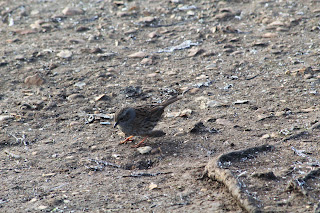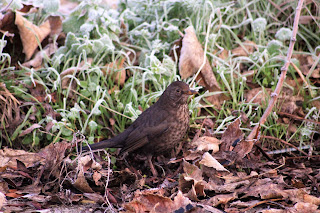Friday, 28 January, 2022
I didn't sleep well the night before, but I still found myself awake not long after sunrise. And so, with the day free before me, and well aware that this weekend is the weekend of the RSPB Big Garden Birdwatch, I took myself from my bed and dressed. I dressed in the layers that I thought a January morning, the sun not long risen, would demand. I took up a notebook, a pen, and my pocket guide to British birds, just in case I saw something unfamiliar.
It became apparent as I settled in the garden that I was right to wear my layers and my warm winter hat; the cold biting at my nose, my fingers, and even my toes - I had decided on my Converse canvas sneakers for footwear, not very sensibly perhaps.
I sat upon a rolled up cheap blanket, the kind you might use for the beach or a picnic, in a corner of the garden where I thought myself least conspicuous to the birds. And I sat, waiting and watching, with my notebook in my lap. To my left, the sun was still low in the sky, climbing.
The lawn was in front of me, the ivy choked borders at the edges. When I turned my head to my right, slowly and with as little noise as I could, my eyes fell on the birdfeeder station, standing about twenty feet away. Suet and seed mix. A window feeder stuck on the french doors holds seed mix too. When I turned my head to my left, I saw the porcelain feeder, shaped like a hollow cactus, hanging amongst the ivy, suet pellets inside.
My cactus feeder (Image from personal collection)
The first birds I see are House Sparrows (Passer domesticus),a bird that has undergone a decline and is now on the 'Red List' of endangered British birds. I recall seeing them in greater numbers last year, when I did Big Garden Birdwatch 2021. But that might be because I did the survey later in the day last year. And I was better concealed then too. I know that we have quite a few House Sparrows visiting the garden - we see them all the time.
A male House Sparrow sat on a slender branch, one rising above the ivy, and gave a few chirping and chattering calls. And I listened, suspecting that he might have seen me, and be chattering about my presence. Three females had flown into the ivy, but they seemed to be remaining silent.
As I sat, I could hear other birds too. I heard a Robin before I saw one, its melody familiar and a favourite. And, when the Collared Dove flew in, it did so with little high pips, before it flew off again with a flap and a fuss.
The Collared Dove (Streptopelia decaocto), we usually see in a pair, but this time it was a solitary visitor. But I could hear the call, even when I couldn't see them. Who-hooo-ho. Who-hooo-ho. Who-hooo-ho.
Collared Dove; scientific name - Streptopelia decaocto (Image from personal collection)
The morning air was cold and clean. It didn't yet carry anything offensive to the senses; none of the thick and greasy takeaway smells; none of the monotonous and heavy bass from music that just seems to go on, and on; none of the screams and whoops from late night party goers; no sirens. Not yet, but it was the weekend, and at least some of that would rear up over the next couple of days.
I miss the countryside, where I grew up.
Dunnocks (Prunella modularis) are a regular sight beneath the feeders, and I saw three of them during my Birdwatch. Apart from the Robin, they were the bird least bothered by my presence. There was distance between us, but they did not seem quite as wary of me as others. They just shuffled around on the ground, picking up bits and pieces of food where they found it.
Dunnock; scientific name - Prunella modularis (Image from personal collection)
From the ivy, now and then, came a Blue Tit (Cyanistes caeruleus) or a Great Tit (Parus major). They both seemed to prefer the suet over the seeds, and would visit either the suet log hanging from the feeding station or the cactus feeder containing the pellets. Like the Dunnock, these two birds are regular visitors but, unlike the Dunnock, they are not quite so calm and relaxed in their visits - they flit onto a feeder, take what they need, and flit away.
As the sun kept rising, it got to a point in the sky where, when I turned to my left, the glare from its light blinded me. I shifted my position a little and all was fine.
In the direction of the rising sun, I saw a Magpie (Pica pica) - I think it was the same bird - flying back and forth with twigs in its bill. But, as per the RSPB's instructions about only recording birds that visit, not birds that fly over, I didn't record the sighting.
Some vilify the Magpie, blaming it for declines in the populations of other birds. But there isn't any evidence that this corvid is really responsible for those declines. In fact, a study, referenced on the RSPB website (https://www.rspb.org.uk), "found that songbird numbers were no different in places where there were many magpies from where there are few. It found no evidence that increased numbers of magpies have caused declines in songbirds and confirms that populations of prey species are not determined by the numbers of their predators."
I always believe that, before we condemn a wild animal, we ought to check our own impact and ask ourselves what we can rectify in our own behaviour. When it comes to songbirds, we might endeavour to put back some of the hedgerows and shrubs that have been removed from the countryside. We might volunteer our time at a local nature reserve. We might rewild our gardens a little bit - garden space in the UK is thought to amount to more green space than all the nature reserves, by about three times as much. There is plenty that we can do about our own intense impact upon the habitat and lives of these birds, before making a villain out of the magpie.
The Robin (Erithacus rubecula), the single Robin that I saw this year, came into the garden and visited my cactus feeder. It looked proud and handsome; its orange-red breast full, and containing the promise of song. And it did sing. It sang its melancholy melody, and I was too stupid to understand it, but I loved it anyway.
European Robin; scientific name - Erithacus rubecula (Image from personal collection)
Two female Blackbirds (Turdus merula) visited the garden. One, a little unsure, took itself to the cactus feeder. She flitted around it for a while, eyeing it with caution. Then she flew into the ivy, close to the cactus and still obviously interested in its contents, but still unsure as to how she should make her approach. She went from the ivy, down to the ground, back up into the ivy . . . Eventually, she flew up quickly, from the ground to the cactus feeder, and knocked a suet pellet or two down to the ground. She flew quickly back down to the ground, picked up her reward, and was off, back into the shrubbery.
Blackbird (female); scientific name - Turdus merula (Image from personal collection)
Time passed. The cold that had been biting to start with became numbing. More birds came and went, and I tried to spot each visitor to the garden. Though they moved so quietly, many not arriving with flaps and flutters, but almost silently.
I don't often watch for birds like this. I prefer to spot birds as I stroll a footpath, rather than sitting and watching for them. But when you do, when you stop and watch for them, it's like meditation.
Some might sniff at the idea of spending an hour like this, just watching and waiting, but that hour didn't stretch and drag. My attention was fixed on my environment and my senses. I was immersed in each and every moment, and I am grateful to each and every visitor that came into the garden. And the others that will come.
My results, submitted to the RSPB's website (Image is a personal screenshot)
I hope that your Birdwatch is a joy.
Thank you for reading. You can support this blog with a coffee from ko-fi.com - the caffeine keeps my eyes open, when I haven't slept well, so that I can spot birds in the branches! Thank you to all supporters!










No comments:
Post a Comment